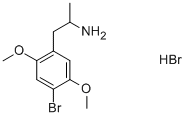| Toxicity | A hallucinogenic (psychedelic) agent that
is obtained by chemical synthesis. It may catalyze severe emotional
problems or psychosis in predisposed individuals, and in
large doses, produces peripheral arterial spasm which, if not
treated, can lead to gangrene. DOB is a potent serotonin 5-HT2
agonist, and although the underlying mechanism of action for
hallucinogens is not well understood, this may be related to its
actions in the CNS. Symptoms include hyperreflexia, restlessness,
perceptual alterations, and illusions, including changes in
touch, taste, and odor, and the thinking process is substantially
altered. At high doses, it causes hallucinations, loss of contact
with reality, and pain and coldness in the extremities at toxic
levels. Therapeutically, peripheral arterial spasm has been treated
with intraarterial tolazoline hydrochloride. Its LD50 is in
mice 80 mg/kg, i.v., in rats 8 mg/kg, i.p., in dogs 4 mg/kg. i.v.,
and in monkeys 2 mg/kg, i.v. |

